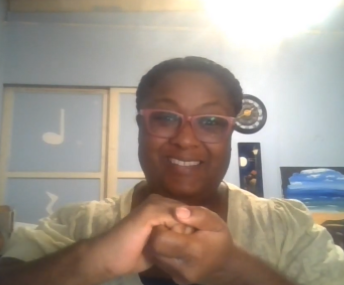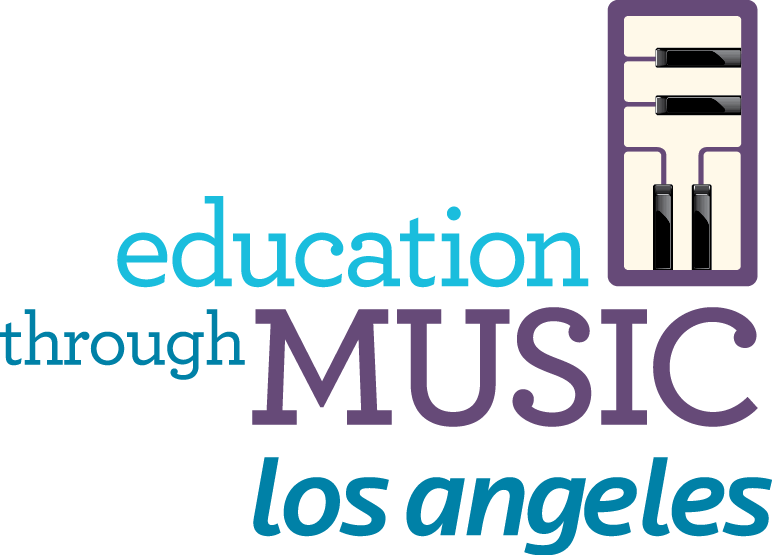Interview with Kimberly, ETM-LA Music Teacher
Black American Sign Language in the Music Classroom
How did you find out about Black American Sign Language (BASL)?
I found a video on Facebook featuring a young woman named Nakia Smith, who is a TikTok-er, and she was raising awareness about Black American Sign Language. She’s a fourth generation individual in her family who is also deaf and hard of hearing, and her family has been passing down that tradition for years. She realized that a lot of people haven’t heard of BASL, so she started to make videos — especially with her grandfather — and it just started catching on. I thought it was so amazing, and it made me really look into what was going on in the deaf community.
A lot of people don’t really do that. A lot of times schools are separated that way — everyone who is abled and people who are disabled are usually in a different facility or separated in the school; you don’t really see them. I didn’t really understand that as an inclusive type of person. One of my best friends was mostly blind, and learning about her experiences really inspired me to look out for others and be inclusive; accept whatever it is you can do to help accommodate others around us, and get to know things from their point of view.

It was very inspiring to hear about BASL. I did a deep dive in my own personal research, because I wanted to know why there’s a whole separate thing out there. And what I learned is that segregation in the regular schools was happening, and it was also happening in the schools for the deaf and blind. It wasn’t until after the Emancipation that they were mandated to make school for colored people, for the deaf and blind. They were smaller properties; sometimes they had teachers who knew a little bit [of sign language], sometimes they had teachers who knew nothing about what they were doing.
There were teachers who could fully hear, expected to teach the students who couldn’t hear — you need people who have that experience and knowledge to really teach the kids. I’ve seen some documentaries where the teacher is just trying to teach them orally — speaking out loud — and they want them to read their lips, and be able to say what they’re saying, too. It was ridiculous — some of the expectations that were put there and so, as an alternative, people in these communities started to say “we know a little bit of ASL; we need to still communicate.” So they just started developing their own ways of communication and spreading the language across different areas from person to person.
It’s a cultural phenomenon, and it’s amazing. I’ve really enjoyed learning about that.
BASL Lean On Me Tutorial Video
What is the historical and cultural significance of BASL? Why did you decide to incorporate BASL into a lesson and performance for your students?
Every year when we get to Black History Month, I try to think outside the box. A lot of times we look at it from the same lens: how music changed through the years and how it progressed in America. I try to figure out different ways to approach it. I definitely wanted to do some type of musical timeline and to highlight different genres. For my 4th grade students, I wanted to do soul and R&B music, and I chose the song “Lean on Me.”
And since I had just learned about Black American Sign Language, I thought, “What if I can find a way to learn some of that so I could share that with the kids?” Then I just so happened to find a video of people signing that song, and some of them had different interpretations and different words that they were using to sign the same song lyrics.
It is really exciting to see how people who are hard of hearing or deaf can still enjoy music. They feel the beat still, and the language itself is like poetry. And then the movement, it’s almost like dance. This says music all over to me, and I wanted to bring that into the classroom. That’s pretty much what we do in class — looking at lyrics, movement and dance — and here is a way that you’re expressing yourself with your hands.
What made you choose “Lean on Me” as the accompanying song?
First I wanted to pay homage to Bill Withers, who was such an amazing musician. His career was not as long as other musicians, but his music is impactful because he really thinks about the words that he is writing. His words are really spoken from the heart.
He has a quote that says he has a true understanding of what he’s feeling, and that’s what he’s going to write. That’s really something because a lot of people have a hard time interpreting how they are feeling, including children.
I feel like this song is especially important during this time, when we’re stuck at home. I can see the fatigue that has started to crawl in on my students. They need somebody to lean on right now; they don’t have their friends that they see every day to talk to. Some of them haven’t been able to travel anywhere or even just go back to their normal life. They need something, some type of outlet, so I felt like this song would be very helpful and uplifting — letting them know that there’s still people out there for them. It felt like perfect timing to use that song and to acknowledge such an amazing songwriter and composer.
How have the students been responding to the lesson? Have they given any feedback?
I gave my students homework on how to say “My name is…” in sign language, and then learning to spell out their names. We also learned that in sign language, sometimes one sign is created for the entire name, and a couple of kids took the extra step to figure that out. That was really great to see.
What do you feel are the positive benefits of the students learning about and performing BASL?
What I’m hoping for is that they have an appreciation for communication. That’s the main thing that they’re missing right now, and I know they want that, but there’s a whole other level of communication that some people don’t have access to. So it’s really broadening their view of getting to just talk to others, and being able to have more connectedness with the people around them.
Also, some students might have behavioral issues in class, and it could be because they don’t feel like they’re being heard. Learning how to express yourself using any form of communication that’s positive is very important.





